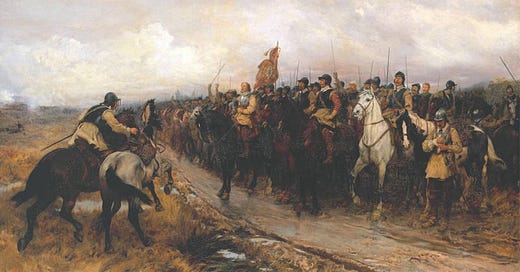History, it has been rightly said, does not repeat itself, but there are “rhymes” and patterns. And as such, history is a repository of wisdom for the present day, if we have eyes to see and ears to hear.
One key lesson that I learned in the 1980s and 1990s when I began the study of the long eighteenth century (1680s-1830s) and the era that preceded it, that of the Stuarts, was that the Puritan victory in the Civil Wars—and it was complete and total—did not eventuate in what they longed for and desired, namely, the creation of a Christian nation.
By 1651, the Parliamentary armies, especially under the charismatic leadership of that remarkable Christian general, Oliver Cromwell (1599-1658), had swept the Royalist oppositon from the field of battle and controlled, it appeared, the future path of the British archipelago. But within ten years—Cromwell had died in the fall of 1658—all of this cultural vicory was in ruins, the monarchy had been restored, and the term “Puritan” would become a byword of reproach and a term of disgust. Indeed, “puritanical” is still a negative term in the English language. And as for Cromwell, his memory was hated in Scotland and Ireland and likewise in many parts of his native England.
The problem was that the Puritans had failed to win the hearts of the English people. They may have set the laws and controlled the institutions of power for a decade or so, but it all amounted to nought in the long run. As John Owen said to his friiend Charles Fleetwood in the 1670s (and this is one of the furst usages of the term “revival” with the sense that we invest it), “
I beseech you to contend yet more earnestly than ever I have done, with God, with my own heart, with the church, to labour after spiritual revivals.[1]
In other words, the Puritan engagement in the great culture war of their day, one that involved literal violence, had failed to accomplish the great goal they so ardently desired, namely, the renovation of the nation and the creation of a godly commonwealth.
The heirs of the Puritans, the 18th-century Evangelicals, learned this lesson well. They knew that it was the power of the Spirit, not political power, that was the key to the renewal of a nation. By no means did they abandon the public square—witness the titanic struggle for the abolition of slavery—but they knew that culture wars are not won by military or legal might, but by the Spirit of the Lord.
Far too many Evangelicals in America (and Canada) today think that if they only control the centres of power, they will bring about the renewal of the nation. In my opinion, on the evidence of these great eras in Church history, that of Puritanism in the era of the Stuarts and that of Evangelicalism during the second half of the long eighteenth century, we need to review again the lessons of those days.
By the way, this is why, I fully concur with Martyn Lloyd-Jones when he described himself as “an eighteenth-century man.” I too am “an eighteenth-century man” for I long for the outpouring of the Spirit of Jesus in power and to see what Howel Harris (1714-1773) once described to George Whitefield (1714-1770) in a 1743 letter:
The outpouring of the Blessed Spirit is now so plentiful and common, that I think it was our deliberate observation that not one sent by Him opens his mouth without some remarkable showers. He comes either as a Spirit of wisdom to enlighten the soul, to teach and build up, and set out the works of light and darkness, or else a Spirit of tenderness and love, sweetly melting the souls like the dew, and watering the graces; or as the Spirit of hot burning zeal, setting their hearts in a flame, so that their eyes sparkle with fire, love, and joy; or also such a Spirit of uncommon power that the heavens seem to be rent, and hell to tremble.
Now, that is power!
[1] John Owen, Letter to Charles Fleetwood, July 8 [1674].




